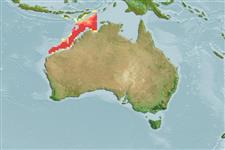Common names from other countries
Elasmobranchii (tubarões e raias) (sharks and rays) >
Rhinopristiformes (Shovelnose rays) >
Rhinobatidae (Guitarfishes)
Etymology: Rhinobatos: Greek, rhinos = nose + Greek, batis, -idos = a ray (Raja sp.) (Ref. 45335); sainsburyi: Named for Dr. Keith Sainsbury..
More on author: Last.
Environment: milieu / climate zone / depth range / distribution range
Ecologia
marinhas bentopelágico; intervalo de profundidade 66 - 200 m (Ref. 58070), usually ? - 150 m (Ref. 58070). Tropical; 5°S - 21°S, 114°E - 135°E (Ref. 114953)
Eastern Indian Ocean and Western Central Pacific: Western Australia to Papua New Guinea
Tamanho / Peso / Idade
Maturity: Lm ? range ? - ? cm
Max length : 59.5 cm TL macho/indeterminado; (Ref. 58070)
Descrição suscinta
Chaves de identificação | Morfologia | Morfometria
This species is distinguished by the following characters: wedge-shaped disc, its dorsal surface scaled but no thorns; snout length 2.5-2.6 times interspiracular distance; orbit moderately large, diameter 1.6-1.9 times spiracle length; nostrils oblique, length 1.4-1.6 times internarial distance; anterior nasal-flaps inserted well into internarial space, but never almost united near ventral midline; posterior nasal flaps broad; ridges of rostral cartilage well-separated dorsally and almost parallel; prebranchial sensory-pore patch narrow, extending to first gill slit; distance between first gill slits 1.3-1.4 times distance between fifth gill slits; distance between fifth gill slits 2.5-2.9 times in ventral head length; postscapular sensory canal long, not grooved, extending more than three-quarters distance to pectoral-fin insertions; moderately tall dorsal-fins; pelvic-fin inner margin distinctly longer than its base in mature males, shorter than base in females; interdorsal distance more than 2.5 times first dorsal-fin base; outer spiracular fold distinctly larger than inner fold; dorsal margin of caudal fin about 2.0-2.2 times preventral margin; 162-171 post-synarcual vertebral centra; about 50 nasal lamellae; dorsal disc plain brownish or with faint dusky blotches or fine dark spots (Ref. 58070).
This species is mostly collected at depths shallower than 150 m. Male individuals mature at 46 cm TL, immature at 37.6 cm TL (Ref. 58070).
Ciclo de vida ou comportamento de acasalamento
Maturities | Reprodução | Spawnings | Egg(s) | Fecundities | Larvas
Last, P.R., 2004. Rhinobatos sainsburyi n. sp. and Aptychotrema timorensis n. sp. -- two new shovelnose rays (Batoidea: Rhinobatidae) from the eastern Indian Ocean. Rec. Aust. Mus. 56(2):201-208. (Ref. 58070)
Status na Lista Vermelha da UICN (Ref. 130435)
Ameaça para os humanos
Harmless
Uso pelos humanos
Ferramentas
Relatórios especiais
Baixar XML
Fontes da internet
Estimates based on models
Preferred temperature (Ref.
115969): 20.5 - 26.8, mean 23.9 (based on 45 cells).
Índice de diversidade filogenética (Ref.
82804): PD
50 = 0.5000 [Uniqueness, from 0.5 = low to 2.0 = high].
Bayesian length-weight: a=0.00295 (0.00151 - 0.00578), b=3.13 (2.96 - 3.30), in cm Total Length, based on LWR estimates for this (Sub)family-body shape (Ref.
93245).
Nível Trófico (Ref.
69278): 3.7 ±0.4 se; based on size and trophs of closest relatives
Resiliência (Ref.
120179): Baixo, tempo mínimo de duplicação da população 4,5 - 14 anos (Preliminary low fecundity).
Fishing Vulnerability (Ref.
59153): Moderate vulnerability (44 of 100).
